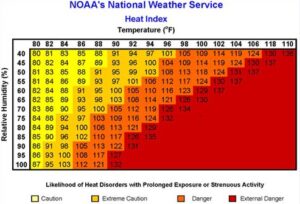
The heat index indicates how hot it feels.
It is expressed as a function of air temperature and the relative humidity. The heat index temperature is for standing in the shade and light winds; when exposed to direct sunlight, the heat index value can be increased by up to 15 degrees.
When our bodies get hot we cool down by sweating. The sweating does not directly cool our bodies; it is the evaporation of the sweat that cools us down. If the air has a high humidity, then the rate of evaporation is reduced. This hampers the body’s ability to maintain a nearly constant internal body temperature. This is why we are uncomfortable on hot, muggy days.
When the temperature is high but the relative humidity is low, the heat index can be less than the actual temperature. This is because cooling by evaporation of sweat is very efficient in these situations. However, high relative humidities prevent evaporation and make it seem hotter than it really is because our bodies cannot cool down. In these cases, the heat index is greater than the actual temperature.
The National Weather Service (NWS) initiates alert procedures when the heat index is expected to exceed 105 to 110 degrees, depending on local climate, for at least two consecutive days. The NWS will issue a heat advisory when the heat index is predicted to be 100 degrees. You are then advised to limit vigorous outdoor activity and drink plenty of fluids. Never leave children or pets in a locked car.
A heat wave is a period of abnormally and uncomfortably hot and usually humid weather. The World Meteorological Organization defines a heat wave as when the daily maximum temperature for more than five consecutive days exceeds the average maximum temperature by 9 degrees.

